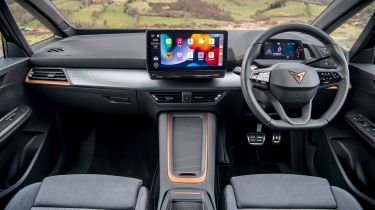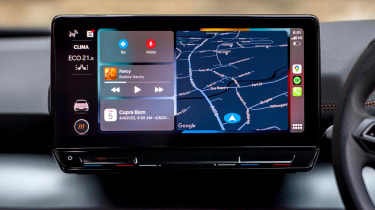Cupra Born review: interior, dashboard & infotainment
The Cupra Born’s interior matches its VW ID.3 rival for quality and distinguishes itself with a sporty driving position and quirky copper accents
Despite costing less than the Volkswagen ID.3, the Cupra Born surprised us when it launched as its cabin felt quite a bit plusher than its VW sister car. While recent updates mean the ID.3 can now match the Cupra in terms of material quality, the Born still trumps its competitor when it comes to infotainment tech.
Cupra Born dashboard
While the Volkswagen ID.3’s cabin can be described as simple and sensible, despite sharing several parts, the Cupra Born’s cockpit manages to feel stylish and sporty. We particularly like how the tall centre console cocoons the driver and front passenger, as well as how all cars get figure-hugging sports seats with integrated headrests. Both elements contribute to the Born’s pseudo hot hatch aesthetic and make each drive feel a bit more of an occasion than in the VW.
Cupra has added some plusher materials to the cabin, which are especially noticeable if you’ve spent time in an ID.3. There’s stitched fabric on the Born’s dashboard, while copper accents help keep the cabin feeling bright. There are still some hard plastics in places, which we felt was actually highlighted by the use of much better quality materials elsewhere.
Our biggest annoyance, however, is the severe lack of physical controls – especially in the air conditioning department. This is adjusted via a set of touch-sensitive sliders which can be finicky at the best of times and aren’t illuminated, meaning they’re almost impossible to operate in the dark. The buttons mounted on the steering wheel aren’t much better, either – although we do like the special quick-access ‘Sport’ button that’s included with e-Boost models.
Equipment, options & accessories
At the time of writing, the Cupra Born is available in three trim levels. The base V1 model is our pick of the range and comes with almost all the kit you could possibly need. Standard specification includes 18-inch alloy wheels, LED headlights, a 12-inch central infotainment touchscreen with sat nav, Apple CarPlay and Android Auto, a heated steering wheel, dual-zone climate control, adaptive cruise control, a reversing camera and safety systems like lane-keeping assistance and driver tiredness alerts.
Upgrading to V2 trim adds 19-inch alloys, an augmented-reality head-up display and heated front seats, while top-spec V3 cars get 20-inch alloys and 12-way power-adjustable heated massage seats up front with luxurious leatherette and suede upholstery.
There are several optional extras to choose from, including a panoramic glass roof (around £1,000) and a heat pump for better efficiency in cold weather (around £1,000). We definitely think the latter is worth adding to boost range in the winter, while keen drivers should opt for the Dynamic Pack (around £800), which includes an adaptive suspension setup.
Infotainment, apps & sat nav
All versions of the Born come with a 5.3-inch digital driver’s display behind the wheel that’s mounted to the steering column, as well as a 12-inch central infotainment touchscreen with wireless Apple CarPlay and Android Auto coming as standard.
While the driver’s display doesn’t offer much in the way of functionality, the main touchscreen is at least larger and more responsive than the one found in the Volkswagen ID.3. The menus are also better laid-out and the graphics are much brighter, although it still isn’t a match for the Google-based system in the latest Renault Megane E-Tech, which is almost as responsive as the best smartphones.





